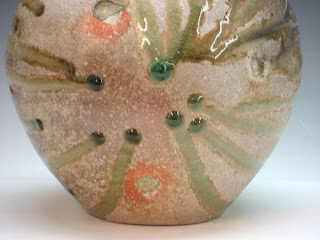I cracked the kiln early on Saturday morning, but it took until 4pm to actually unload the kiln. I had a few problems with crawling on two of the carved porcelain bowls, the glaze just dried to slowly, leading to the eventual crawling. Everything else came out fine and the cap jars exceeded my expectations. It is always nice when that happens.
It is not my intension to regal any reader with the daily minutia and travails of each of my work cycles, I just wanted to give a glimpse as to how I work. I do not plan to make this a regular thing. A new week now and a new cycle of work, the life of a potter.
(Illustrated, a cap jar and wall bowl from this firing, together with a close up of the bowl. The bowl is about 15” in diameter for scale.)




